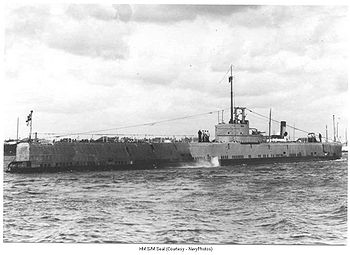HMS Seal (N37)
| HMS Seal UB 
|
||
|---|---|---|
| General data | ||
| Ship type : | Submarine | |
| Ship class : | Porpoise class | |
| Navy : | ||
| Keel laying : | December 9, 1936 | |
| Launch : | September 27, 1938 | |
| Commissioning: | May 24, 1939 | |
| Builders : | Chatham Dockyard ( Chatham ) | |
| Whereabouts: | ||
| Sister ships | ||
|
|
||
| For technical data, see: Porpoise class |
||
HMS Seal (Seal) was a British submarine of the Porpoise class in World War II , that of the German Navy captured and then called UB was put into service. It was the only submarine that the German armed forces could capture at sea.
HMS Seal
HMS Seal was one of six British Porpoise-class mine-laying submarines. The boat was launched on September 27, 1938 at the Chatham Dockyards in Chatham and entered service on January 28, 1939 under the command of Lieutenant Commander Rupert Philip Lonsdale of the Royal Navy .
When the Second World War began, the boat was in Aden . It went on its first war patrol in the Gulf of Aden , then it was ordered back to England. This was followed by a number of trips in the North Sea and a deployment as an escort ship for a convoy in the Atlantic . The Seal was then seconded to the 6th Submarine Flotilla.
On April 29, 1940, the Seal ran from Immingham for Operation DF 7. The aim of the operation was to lay a mine barrier near the Swedish island of Vinga in front of the port city of Gothenburg ; for this purpose, the boat carried 50 sea mines. The area of operation was in the sea route from Germany to Norway , which was on 9/10 April 1940 was occupied by the German Reich (" Enterprise Weser Exercise "). On May 4, around 2:30 a.m., the boat was attacked and slightly damaged by a German Heinkel He 115 of Coastal Aviation Group 76, which had started from Aalborg in occupied Denmark . The same day around 9 o'clock the boat began to lay its mine barrier; after three quarters of an hour this work was finished. An emerging German sea patrol caused the boat's captain to dive. During the dive, the boat triggered a sea mine at around 6.30 p.m., causing it to be seriously damaged. The boat was aground at a depth of about 30 meters until 1:30 a.m. on May 5th. Then the crew, who were increasingly suffering from carbon dioxide poisoning, managed to bring the boat to the surface of the water. The stern of the boat was partially flooded, but it was still possible to start an engine. Due to the damage to the steering gear, the boat could no longer be steered, but the crew tried to bring it into Swedish waters so that it could be interned in neutral Sweden . An hour later, the boat was spotted by a German Arado Ar 196 , which attacked the boat with two bombs and machine gun fire. The Seal , who was not sure about diving, tried to fight the aircraft with her own machine gun, but it jammed . A second Ar 196, which joined the battle a few minutes later, also attacked the boat. The failure of its own Lewis Gun and the wounding of some crew members prompted Ltd. Com. Lonsdale to give up the fight and surrender to the two German planes. Around 6:30 in the morning, the German submarine hunter UJ 128 (the former trawler Franken ) appeared and towed the boat into the Frederikshavn naval base . The sixty-strong crew of the Seal thus became a prisoner of war .
On May 11th the boat was towed to Kiel and repaired there at the Germania shipyard .
Four ships sank on the mine barrier laid by the Seal : on May 5th the small Swedish ship Aimy , on May 6th the German freighter Vosges (4241 GRT), on May 28th the Swedish freighter Torsten (1206 GRT) and on May 5th. June the Swedish freighter Skandia (1248 GRT).
From the English nautical charts captured on the Seal , a mine barrier in front of the Ems and a mine barrier in front of the southern Norwegian coast could be recognized and both cleared. When the mine lock was cleared off southern Norway, the German minesweeper M 11 hit a mine on June 6, 1940 and sank.
UB
On November 30, 1940, the submarine under the designation UB was put into service with the Navy after the repairs were completed. The new commander was frigate captain Bruno Mahn , one of the oldest commanders of a German submarine in World War II. At that time he was already 52 years old and had commanded the submarine SM UB 21 during the First World War .
UB had only very limited military value for the Navy, as the British standards and weapons were not compatible with the German ones and retrofitting the boat would have been more expensive than building a new one. The boat was therefore only used for training purposes. In addition, the capture of the boat was exploited for propaganda purposes. The British torpedoes captured with the Seal had the greatest value, the analysis of which flowed into the development of new torpedo detonators, which had become urgent due to the torpedo crisis of the German submarines during the Weser exercise .
UB was decommissioned on July 31, 1941, and self- sunk on May 3, 1945 near Kiel in the Heikendorfer Bay ( 54 ° 22 ′ 0 ″ N , 10 ° 11 ′ 0 ″ E ). The wreck was later lifted and scrapped.